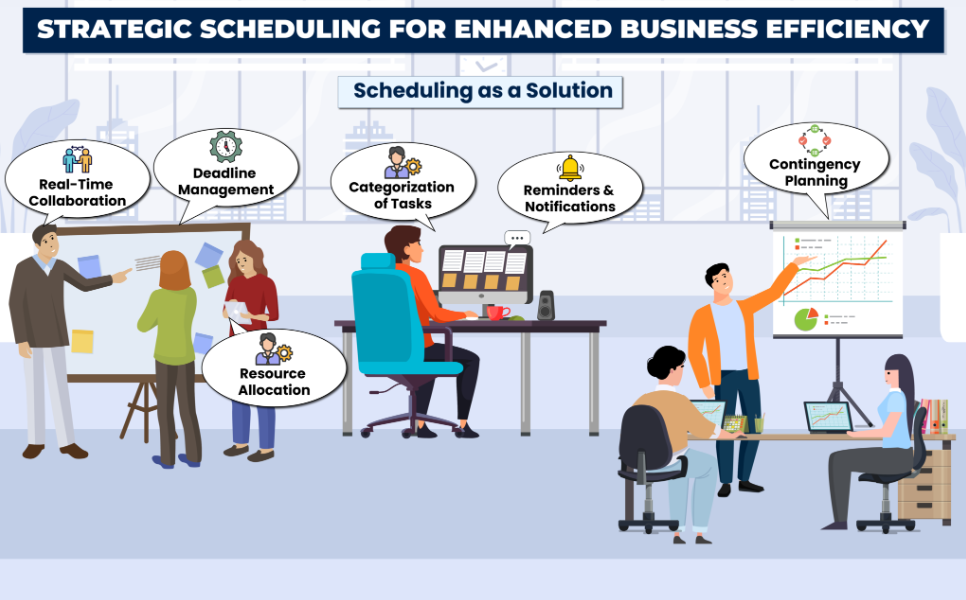
In a business environment, scheduling refers to the process of allocating resources, tasks, and activities within a defined timeframe to achieve specific objectives. Whether it involves coordinating production processes, managing employee shifts, or scheduling client appointments, scheduling lays the groundwork for streamlining operations and maximizing output.
Here are some common challenges in task management faced by enterprises and how scheduling can help to tackle them:
Challenge 1: Organizing Tasks
Without a structured approach to task management, individuals or teams may find themselves overwhelmed by the sheer volume of tasks, unsure of where to start, and prone to overlooking important deadlines or details. This lack of organization can lead to confusion, stress, and ultimately, inefficiency in completing tasks.
How scheduling can help?
Scheduling allows you to assign priorities to tasks based on deadlines, importance, or dependencies. By scheduling tasks according to their priority level, you ensure that the most critical tasks are completed first. Scheduling helps allocate specific time frames for different tasks or categories of tasks.
Challenge 2: Lack of Communication
In larger organizations or those with multiple departments, coordinating tasks among different teams can be difficult. Miscommunication, conflicting priorities, and differing interpretations of tasks can lead to inefficiencies and delays.
How scheduling can help?
A centralized scheduling system promotes visibility into task assignments, timelines, and dependencies across different teams and departments. By sharing a common schedule, teams can align their efforts, clarify priorities, and identify potential conflicts or overlaps in task assignments. Scheduling tools with collaboration capabilities enable team members to work together on tasks, share progress updates, and communicate in real time.
Challenge 3: Tracking & Monitoring
Tracking the progress of tasks and holding team members accountable for their responsibilities can be challenging, especially in remote or distributed teams. Establishing clear metrics for measuring progress and implementing systems for monitoring performance is essential for effective task management.
How scheduling can help?
A well-designed schedule serves as a roadmap by setting clear deadlines and milestones so that team members can track their progress and evaluate their performance against predetermined metrics. It can store historical data on task completion times, resource allocation, and performance metrics. Scheduling also facilitates regular check-ins and progress reviews, allowing managers to provide feedback, address issues promptly, and ensure that tasks are completed as planned.
Challenge 4: Time Constraints
Business operations often involve a multitude of complex tasks that need to be managed simultaneously. These tasks may have dependencies on each other, varying levels of priority, and different timelines. Employees may face difficulties in managing their time, resulting in delays and bottlenecks in task completion.
How scheduling can help?
Establishing a robust scheduling system can help allocate time effectively by breaking down complex tasks into smaller, manageable chunks. By scheduling specific time slots for each task, employees can mainstream their workload, ensuring that essential tasks are completed on time without feeling overwhelmed.
Challenge 5: Resource Availability
Allocating resources such as time, manpower, and budget to different tasks requires careful organization and collaboration. Limited resources may result in competing demands, forcing businesses to make trade-offs and prioritize certain tasks over others.
How scheduling can help?
By creating a comprehensive schedule, organizations can assess resource availability and adjust priorities accordingly, minimizing conflicts and ensuring that essential tasks receive the necessary resources to be completed diligently.
Challenge 6: Disrupted Workflow
Procrastination of tasks can cause a domino effect, impacting the completion of subsequent tasks and affecting the overall process outcome and the company’s bottom line. Addressing this challenge requires implementing strategies such as setting clear deadlines, providing adequate support and resources, and fostering a culture of proactive task completion.
How scheduling can help?
Scheduling combats procrastination by establishing deadlines and creating a sense of urgency around task completion. Scheduling allows for proactive planning and resource allocation, reducing the likelihood of last-minute rushes and ensuring that tasks are completed on time. By adhering to a systematic schedule, individuals can maintain focus, minimize distractions, and ensure continuity in their workflow.
Every organization should be equipped with approaches to become most efficient with task management and scheduling is a process that is critical for the same as it allows for realistic goal-setting and helps in managing expectations, both for individuals and teams, and maintain a balance between different tasks and responsibilities.
The evolution of scheduling methods has progressed from traditional manual processes to modern, technology-driven solutions aimed at optimizing business activities.
Traditional scheduling methods involved manual processes using tools such as pen and paper or basic spreadsheets. These static schedules were created in advance and lacked the flexibility to accommodate changes or unexpected events. Communication among team members was often fragmented, leading to coordination issues.
The introduction of digital calendars marked a significant improvement, providing easier organization of tasks, better visibility into team members’ availability, and simplified communication through shared calendars and invitations. However, digital calendars still lacked advanced features for complex scheduling scenarios.
Advancements in technology led to the emergence of sophisticated scheduling software solutions. These solutions automated repetitive tasks, improved collaboration among team members, integrated with other business applications, and offered customization to meet specific organizational needs.
Establish a Smooth Scheduling Process With Smart Food Safe
Smart Food Safe is a cloud-based software with applications to optimize business operations that enable employees to plan, schedule, and track their projects while collaborating online with their teams.
We offer centralized planning through its one-stop platform, allowing users to meticulously organize and schedule task timelines, and resources in a single accessible location, streamlining execution of tasks. Real-time notifications keep users informed about project progress, alerting them to any schedule changes or delays, and enabling immediate action. Furthermore, Smart Food Safe fosters a collaborative environment by providing team members access to its online platform, facilitating easy communication, updates sharing, and real-time task collaboration, regardless of their location or working conditions. With Smart Food Safe, you can set up an uninterrupted scheduling system that maximizes business efficiency, minimizes delays, and drives success.
_1.png)